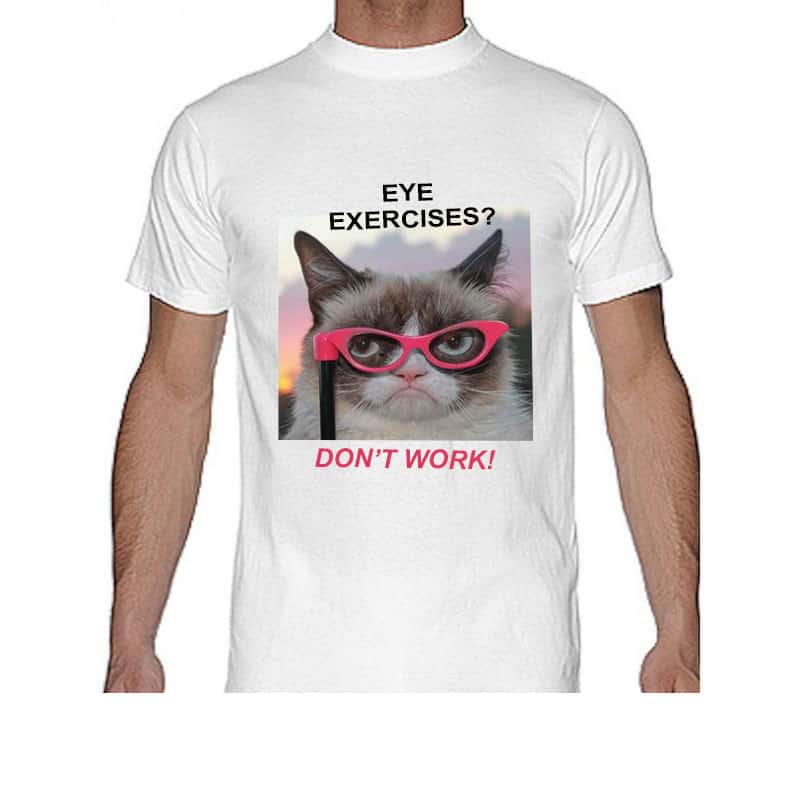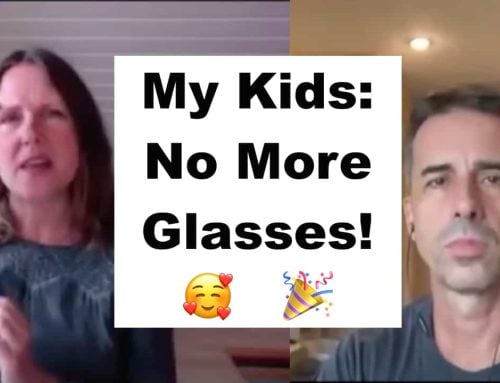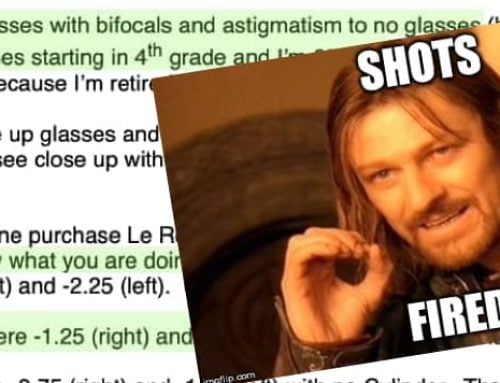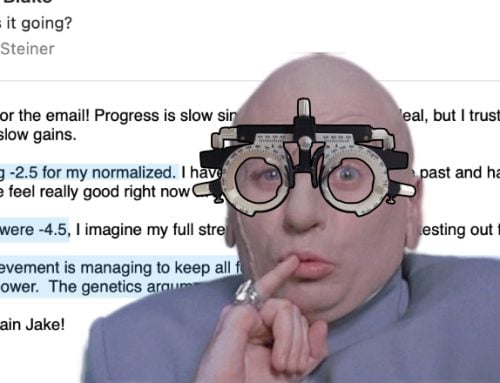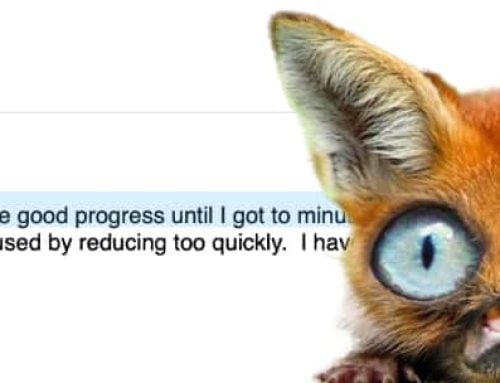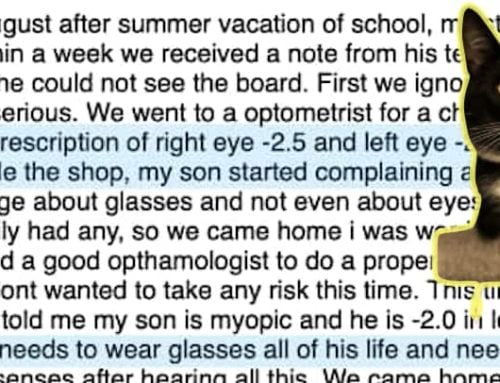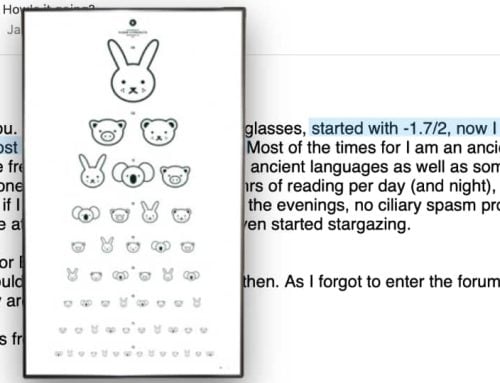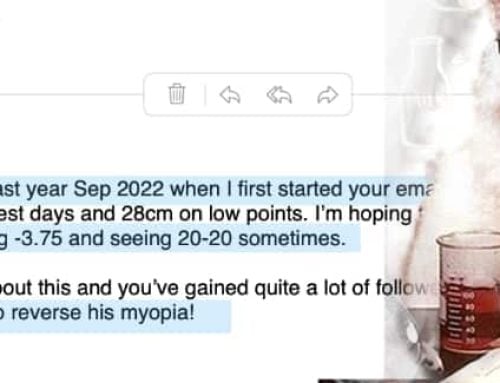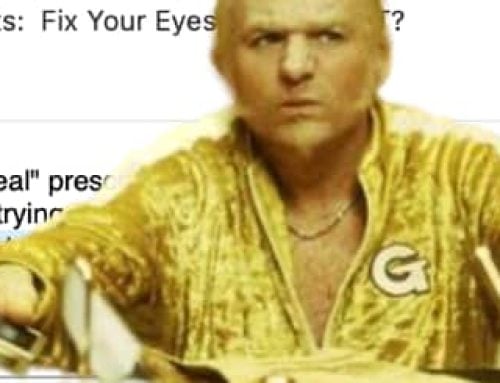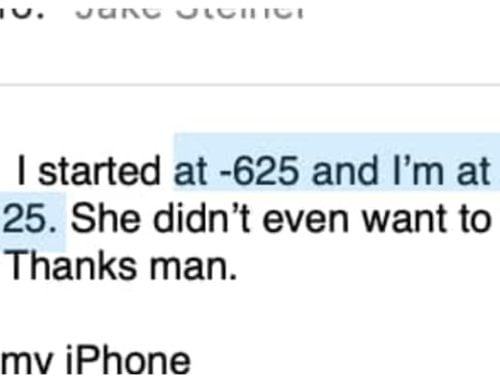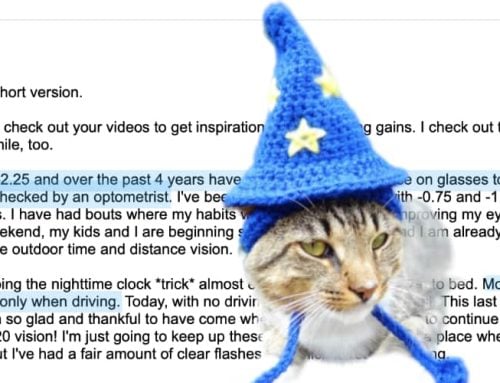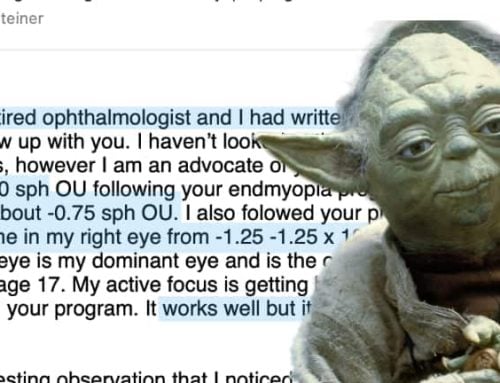Eyesight exercises don’t work. If we ever start a swag shop, that’ll be on the first t-shirt.
What does work, is habits. And where there are habits, and change, and challenge, there’s emotion. It’s something you want to consider and be ready for. You’re not going to jump in and start seeing better, without some ups and downs.
So if you’re working on improving your eyesight (or kind of wishing it was a real thing), this is for you.
Posted by Matthew:
Great forum posts from everyone recently. I thought I’d chime in more on emotions and eyesight. Hopefully, there’s a productive conversation here that doesn’t take away from the essentials of reduced strain, positive stimulus, rehabilitative prescriptions, and keeping a log.
As I’ve written previously, I did not want to get glasses. Hated the idea. I managed to make it a good six months where I couldn’t read the board in school before anyone figured it out. One day I asked my Dad what time it was when I should have been able to read the clock across the room. I heard the words coming out of my mouth and I knew I’d blown it. Game over. Lifetime of glasses.
I did not want to wear that first pair of glasses, but within a few weeks I basically just accepted my fate. Everyone in my family wore glasses, so now it was my turn. I tried to forget about it. Then, for the next five or six years, I would need a stronger prescription every year. The first few days of the new prescription were always horrible. I’d get a headache and feel disoriented. I was told that I would get used to it. Never did, but I thought I couldn’t do anything about it, which I also hated. At one point, I remember thinking, “every time I get a new prescription, my vision gets worse. What if I just didn’t get a new prescription?” But, I didn’t know of anyone who talked about eyesight improvement, so this line of thought didn’t go anywhere. A few times during this time period, my glasses got knocked off my face. Moments of panic settled in – ” I can’t do anything without my glasses! I NEED THEM! I’m helpless, I hate this! Why can other people SEE?”
Fast forward to April of 2014. I had accepted my fate and assumed that my children would be stuck with the same lousy vision I had. I stumbled on to vision improvement, and for the first time, didn’t feel the helplessness of needing glasses, but HOPE. As I learned more, and actually saw my vision improve, hope turned into exuberance. It was like a was a kid again, and someone told me, “I can show you what to do so that you’ll never need glasses!” I would have done anything.
I’ve now moved past the rapid improvements of ciliary strain and overprescirption, so the improvements are no longer on a straight line. There’s fluctuations, and so too, do my emotions fluctuate. As others have written about, and as Jake did on his recent blog post, when I see a decline in my cm, or have a “worse” vision day, the bad emotions try and come back. “Do you really think you can get rid of those glasses? You don’t know anyone whose ever improved his vision! Give up, you can’t escape your genetics.” Except because of the forum, I do know people who’ve beaten back their myopia. And with my log, and my old, overprescribed glasses, I have the proof that I’m on my way, too.
Then, I have a good vision day, or good vision moment. I get a clear flash. Or I look at some larger text across the room without my glasses on, and I watch the double images fuse into something I can read. Then I’m excited again, I’m a kid, and I met the secret mentor, maybe an Obi Wan Kenobi, who teaches me how to find my clear vision again. The clearer vision was always there, active focus available at a moments notice, I just didn’t know that it existed. Now I have a special power, I can move my vision back in the other direction.
As so it goes, back and forth. Maybe I’m wearing a normalized, and working to bring something distant into focus, and someone else around me, who has never needed glasses, can read it easily. Confidence shot, “this isn’t working, you should be able to see that. Give up, you’ll always need glasses,” so says that voice. Then, I stop by the dollar store on the way home, pull my glasses off, and put on some +2 lenses, and look into the distance just to see what my world without glasses used to look like. This reminds me to stay the course, and be patient. I had glasses for 22 years before I did anything to move my vision in the other direction. Right now, it looks like three years total will be about my timeline to be functional without glasses. 3 years for rehab against 22 years of abuse. Not bad. What if it takes 4 years? Still pretty good.
So, for context, when I write about myopia being emotional, this is my story, the things that go on in my head. I could go in to more things: how Bates and other internet programs are seductive because they try to link the subjective emotional element of vision to what we do objectively (strain reduction, positive stimulus, rehabilitative prescriptions, and logs WITH OBJECTIVE measurements), how glasses tend to reduce peripheral vision which can be correlated with calmer, more meditative brain wave states, how looking into the distance more habitually tends to improve posture, which is positively correlated with increased confidence and positive emotions versus a depressed, slouched and head forward state that too many myopes have, or any of the other peripheral topics connected to vision improvement.
But, while all this stuff is fun to talk about, if it is the total focus of our attention, it either misses the point or can get us (me, at least) distracted from the main issue. GET POSTITIVE STIMULUS, reduce strain, reduce prescriptions slowly over time, and all the rest will take care of itself.
Conclusion? Yes, vision improvement is very emotional for me, back the path back from myopia is measured, objective, and simple.
And from Steve:
VERY nice narrative Matthew! We all have our own story, filled with emotion influenced directly or indirectly by our vision and perception of the world based on how well we can see.
In order to get to this point, we had to question the advice given to us at one point or another to find our way out. When given a shovel and asked to dig straight down, one would hope to ask…how deep or for how long? But we’re just told to keep digging even after we are over our heads. Pretty soon, the sky gets darker and we don’t even know how to get out of the hole we’ve been digging ourselves into.
Sure, you can stop digging and hope someone drops you a ladder, or you can start digging sideways and build yourself a ramp to get back out. How long it takes to get out depends on how deep you were able to dig.
Every day I wake up to a blurry world. I’m used to that. I could immediately put my glasses on or insert contacts into my eyes, but I don’t. Not right away at least
I’ll take a few minutes to take in how I can see the shapes of objects or judge the distance to the door that much better than I did a few months ago. I look at my phone and realize that I don’t have to hold it right up to my nose anymore to see the time, check email, etc. In the bathroom, I can see make out the labels of shampoo bottles just a tiny bit better than I used to. I’m building my ramp to freedom, ever so slowly. The world gets clearer with every bit of dirt I pound beneath my feet. The trick is to keep looking up, not down.
This process could take me upwards of 8-10 years. I’m almost 2 years in now and I have close to 10 pairs of glasses now. Every once in a while, I put on an older normalized or differential and get reminded how much clearer I can see compared to when I first started wearing them.
My first differential was a -5OS, -4OD and I could not even make out the 20/200 line on my snellen when I first got them in March 2014. Back then, I thought they were USELESS to me. Now, I have started using them as my normalized and can see 20/40, sometimes 20/30 in good light.
You can’t move forward until you remind yourself of the past every now and then!
Build that ramp!
Starting Rx
[Feb 2014] OS -7.50d, -1c | OD -6.00d, -1.25c
Optometrist [May 2015] OS -6.75d, -1c | OD -5.25d, -1c
Current Normalized: [20/40] OS -5.00d | OD -4.00d (spherical)
Current Differential: [~50cm] OS -4.25d | OD -3.25d (spherical)
Current CM: OS 16cm | OD 20cmFull thread in Emotions and Eyesight (if you have forum access).
What can I add to that? Those guys really spell it all out.
I do get a fair bit of suggestions on how to make the site look more credible (their words, not mine). But to be honest, it’s doesn’t really feel like a huge priority. I’m still (perhaps irrationally) a bit fond of the whole idea that you have to put in the work, to find your answers. I don’t feel an urgent need to convince every single last casual visitor that they could improve their vision. If anything I’d like to make the whole site plain text, and hide the success stories posts. :-)
Cheers,
-Jake


